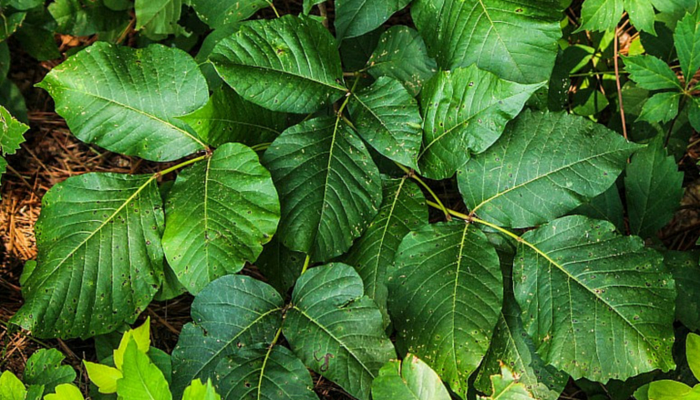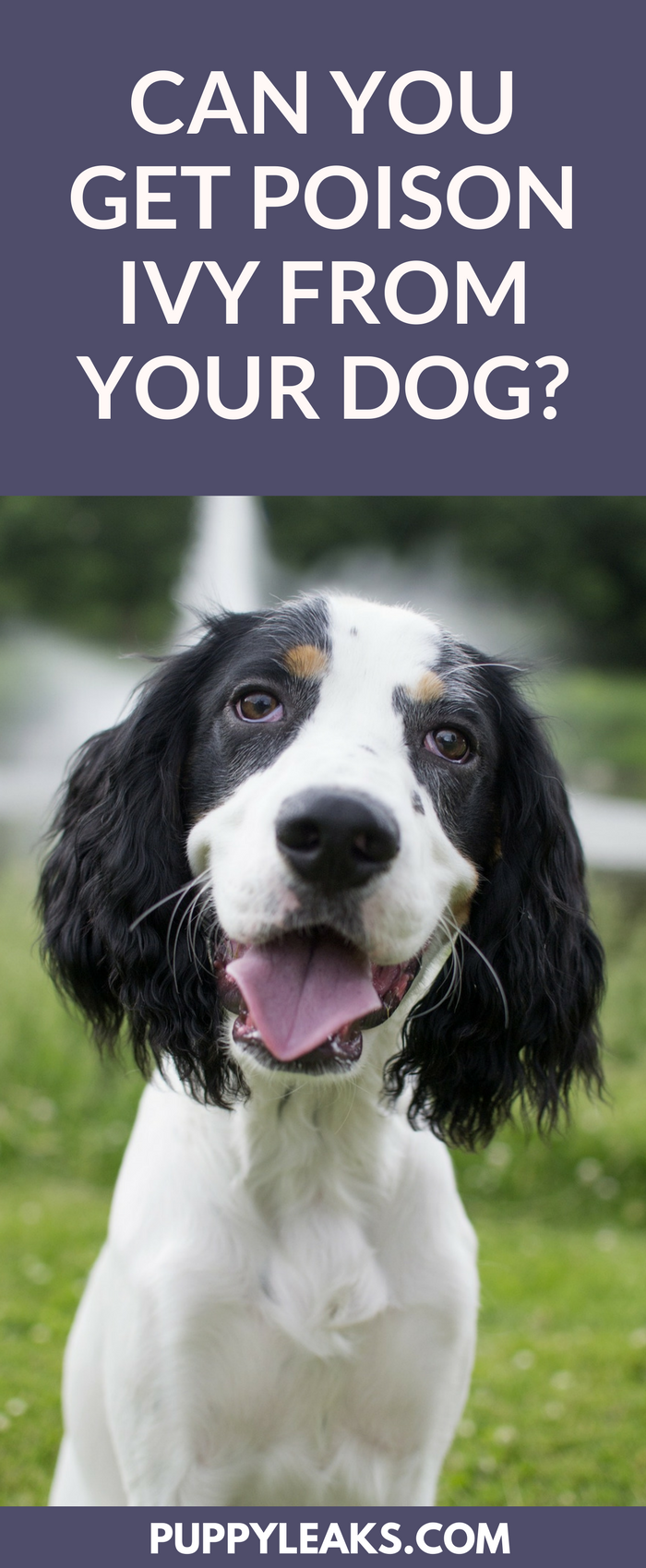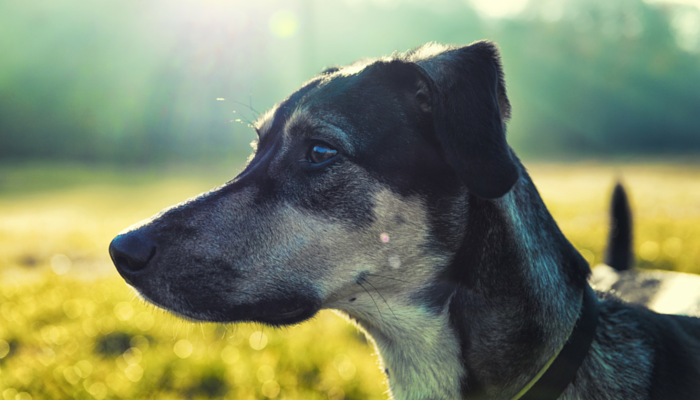Can You Get Poison Ivy From Your Dog?
I moved out of the suburbs and into a wooded area a few years back, and it wasn’t long after that I got poison ivy for the first time. I shrugged it off and attributed it to bad luck.
Since I don’t have a habit of reaching out and touching all the weird plants I come across I figured I’d be safe. I continued to take my dog for her daily walk in the woods, oblivious to all the potentially poisonous things we we were walking through.
So you know what happened? I got poison ivy. Not once, not twice, but three times in the first couple years here. Looking back I’m pretty sure I got poison ivy from my dog. Turns out poison ivy doesn’t typically effect dogs, but the oil from it can be transferred from their coat and onto us.
Can You Get Poison Ivy From Your Dog?
Can you get poison ivy from you dog? The short answer is yes — urushiol oil that gets on your dog can be transferred onto you.
So if you’re out walking with your dog and suspect you may have run into some poison ivy the best thing you can do is wash them and yourself as soon as possible to help prevent a reaction. Poison ivy oil can linger for some time on a dog’s coat, and it only takes a tiny amount getting on your skin to cause a reaction.
The rash itself that poison ivy causes is not contagious from your dog, but any oil from the plant that ends up on your dog can spread to you. And in most people it only takes a very small amount of urushoil (a liquid compound in the plant’s sap) to cause a reaction.
When exposed to 50 micrograms of urushiol, an amount that is less than one grain of table salt, 80 to 90 percent of adults will develop a rash. – CDC
How to Prevent Getting Poison Ivy From Your Dog
If you suspect your dog has come into contact with poison ivy avoid any petting and wash him immediately. The quicker that oil is washed off the better the chances of avoiding a reaction. Be sure to also wash your clothing and any towels you use immediately after washing your dog to prevent any contact with lingering oils.
Prevent Catching Poison Ivy From Your Dog By:
- Wash your pet immediately after exposure
- Wash multiple times to ensure the oil is removed
- Wash your dogs collar & leash
- Wear rubber gloves & long sleeves to prevent the oil from spreading to you
- Wash your clothing & towels after bathing your dog to prevent further exposure
- Take a shower to get rid of any possible lingering oils on your skin
Can Dogs Get Poison Ivy?
Although dogs can get poison ivy it’s not nearly as common as it is in humans thanks to their fur which acts as a protective barrier. Short haired and hairless breeds are more at risk for developing the rash, and areas that have less fur such as the belly are more susceptible.
Pets are not quite as likely to develop the rash from urushiol as people because the hair coat is somewhat protective, but if your pet has a rash of any kind, it is wise to see a vet. – Dr. Kathryn Primm, Iheartdogs.com
Symptoms of a Poison Ivy Reaction in Dogs
The reaction that dogs have to poison ivy is just like our own, and the symptoms can take up to a week to develop. The typical symptoms of a poison ivy reaction in dogs are:
- Increased itching & scratching
- Increase in licking
- Red, blister-like raised bumps on the skin
- Inflamed skin
- Open sores
As the oil spreads onto your dogs skin they’ll begin to develop a rash with raised bumps that resemble blisters. The skin will redden and become extremely itchy.
As the plant’s oils sink into your dog’s skin, red bumps that resemble pimples — known as papules — will emerge, causing your pet to itch and his skin to redden, much like the reaction humans experience. – Dr. Scott Perry, Care.com
Dogs can develop a severe reaction if they ingest the plant. If you think your dog has ingested poison ivy it’s time for a trip to the vet.
While we can use calamine lotion to soothe our own poison ivy it can be toxic to your pet. If your dog has come into contact with poison ivy and they start showing signs of a rash or extra itching consult your veterinarian.
Identifying Poison Ivy
Poison ivy usually grows as a vine or shrub, and it’s found throughout most of America except for Hawaii & Alaska. It can grow in open fields, wooded areas, and roadsides, and it can be found in both rural and urban areas.
Poison ivy plants have three pointed leaves, though depending on species this can vary. Some plants have yellow or green flowers, and others have white berries depending on the time of year. The leaves are typically green in the spring and turn red in fall.

“If it has three, let it be” Poison ivy plants have 3 leaves, but they’re not always easy to identify because of their many color & shape variations.
Tips For Preventing Your Dog From Getting Poison Ivy
The best way to prevent poison ivy getting onto your dog is by limiting their exposure to it. If you have poison ivy in your yard don’t leave them unattended, and if you’re going to be walking in wooded areas with your dog keep them on a leash.
Learn to identify poisonous plants so you can avoid them while out hiking with your dog. If you’re not familiar with identifying plants you can stick to sidewalks & the streets in your neighborhood for your daily walk.
Conclusion
Don’t be like me. Don’t assume that just because you’re not out touching every plant you see that you won’t get poison ivy. You can get poison ivy from your dog from the oils that linger on their coat.
It only takes a tiny amount of oil on your skin to cause a reaction, and that oil lingers and can easily spread from your dog or clothing. If you’re going to be walking your dog out in the woods it’s a good idea to wash them & your clothing afterwards.

Please share with your friends.

Great article! It’s happened to me before too and it was awful!
Both my husband and myself are highly allergic to it. I try to keep the dogs as far away from it as possible because I’m never sure which three leafed plant it is!
I pretty much just point at everything that has 3 leaves and say “yep, it’s poison ivy,” though I’m sure I’m wrong at least 90% of the time.
can your dog get poison ivy from you?
Now that’s an even better question. They can get it from us, but it’s extremely uncommon since their fur generally protects them pretty well & it would be dependent on a secondary transfer of oil.
The same exact thing happened to me years ago! We have poison ivy by one of the fences on our property and while I hadn’t been over there, Shiner was. I was pregnant, grumpy, and itchy!
What a helpful post, I was just wondering about this!
Love & biscuits,
Dogs Luv Us and We Luv Them
Oh my god I wish I read this 5 days ago !!!!!!!!!
I have poison oak or ivy ! Because I was forging for my tortoise! So thanks to antibiotics and Benadryl, and lotion .First time getting any of this . Husband asked you wont do it again, I said yes I will but wont touch my body. I will wash first. It’s on my neck arms and thy . Itchy as heck!!!!!!
This happens to me every summer, we live in the woods and let our dog roam free. He gets into poison oil and then lays in our bed. So I can count on every summer constantly having some kind of poison, its usually on my arms and face. I’m not going to give my dog a bath every time it goes outside and comes back in.